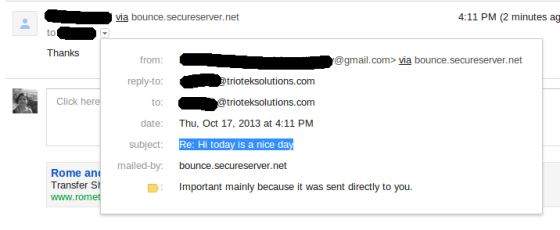
- JavaMail API Tutorial
- JavaMail - Home
- JavaMail API - Overview
- JavaMail - Environment Setup
- JavaMail - Core Classes
- JavaMail - Sending Emails
- JavaMail - Checking Emails
- JavaMail - Fetching Emails
- JavaMail - Authentication
- JavaMail - Replying Emails
- JavaMail - Forwarding Emails
- JavaMail - Deleting Emails
- JavaMail - Gmail SMTP server
- JavaMail - Folder Management
- JavaMail - Quota Management
- JavaMail - Bounced Messages
- JavaMail API Protocols
- JavaMail - SMTP Servers
- JavaMail - IMAP Servers
- JavaMail - POP3 Servers
- JavaMail API Useful Resources
- JavaMail - Quick Guide
- JavaMail - Useful Resources
- JavaMail - Discussion
JavaMail API - Replying Emails
In this chapter we will see how to reply to an email using JavaMail API. Basic steps followed in the program below are:
Get the Session object with POP and SMPT server details in the properties. We would need POP details to retrieve messages and SMPT details to send messages.
Create POP3 store object and connect to the store.
Create Folder object and open the appropriate folder in your mailbox.
Retrieve messages.
Iterate through the messages and type "Y" or "y" if you want to reply.
Get all information (To,From,Subject, Content) of the message.
Build the reply message, using Message.reply() method. This method configures a new Message with the proper recipient and subject. The method takes a boolean parameter indicating whether to reply to only the sender (false) or reply to all (true).
Set From,Text and Reply-to in the message and send it through the instance of Transport object.
Close the Transport, folder and store objects respectively.
Here we have used JangoSMPT server via which emails are sent to our destination email address. The setup is explained in the Environment Setup chapter.
Create Java Class
Create a java class file ReplyToEmail, the contents of which are as follows:
package com.tutorialspoint;
import java.io.BufferedReader;
import java.io.InputStreamReader;
import java.util.Date;
import java.util.Properties;
import javax.mail.Folder;
import javax.mail.Message;
import javax.mail.Session;
import javax.mail.Store;
import javax.mail.Transport;
import javax.mail.internet.InternetAddress;
import javax.mail.internet.MimeMessage;
public class ReplyToEmail {
public static void main(String args[])
{
Date date = null;
Properties properties = new Properties();
properties.put("mail.store.protocol", "pop3");
properties.put("mail.pop3s.host", "pop.gmail.com");
properties.put("mail.pop3s.port", "995");
properties.put("mail.pop3.starttls.enable", "true");
properties.put("mail.smtp.auth", "true");
properties.put("mail.smtp.starttls.enable", "true");
properties.put("mail.smtp.host", "relay.jangosmtp.net");
properties.put("mail.smtp.port", "25");
Session session = Session.getDefaultInstance(properties);
// session.setDebug(true);
try
{
// Get a Store object and connect to the current host
Store store = session.getStore("pop3s");
store.connect("pop.gmail.com", "xyz@gmail.com",
"*****");//change the user and password accordingly
Folder folder = store.getFolder("inbox");
if (!folder.exists()) {
System.out.println("inbox not found");
System.exit(0);
}
folder.open(Folder.READ_ONLY);
BufferedReader reader = new BufferedReader(new InputStreamReader(
System.in));
Message[] messages = folder.getMessages();
if (messages.length != 0) {
for (int i = 0, n = messages.length; i < n; i++) {
Message message = messages[i];
date = message.getSentDate();
// Get all the information from the message
String from = InternetAddress.toString(message.getFrom());
if (from != null) {
System.out.println("From: " + from);
}
String replyTo = InternetAddress.toString(message
.getReplyTo());
if (replyTo != null) {
System.out.println("Reply-to: " + replyTo);
}
String to = InternetAddress.toString(message
.getRecipients(Message.RecipientType.TO));
if (to != null) {
System.out.println("To: " + to);
}
String subject = message.getSubject();
if (subject != null) {
System.out.println("Subject: " + subject);
}
Date sent = message.getSentDate();
if (sent != null) {
System.out.println("Sent: " + sent);
}
System.out.print("Do you want to reply [y/n] : ");
String ans = reader.readLine();
if ("Y".equals(ans) || "y".equals(ans)) {
Message replyMessage = new MimeMessage(session);
replyMessage = (MimeMessage) message.reply(false);
replyMessage.setFrom(new InternetAddress(to));
replyMessage.setText("Thanks");
replyMessage.setReplyTo(message.getReplyTo());
// Send the message by authenticating the SMTP server
// Create a Transport instance and call the sendMessage
Transport t = session.getTransport("smtp");
try {
//connect to the smpt server using transport instance
//change the user and password accordingly
t.connect("abc", "****");
t.sendMessage(replyMessage,
replyMessage.getAllRecipients());
} finally {
t.close();
}
System.out.println("message replied successfully ....");
// close the store and folder objects
folder.close(false);
store.close();
} else if ("n".equals(ans)) {
break;
}
}//end of for loop
} else {
System.out.println("There is no msg....");
}
} catch (Exception e) {
e.printStackTrace();
}
}
}
You can set the debug on by uncommenting the statement session.setDebug(true);
Compile and Run
Now that our class is ready, let us compile the above class. I've saved the class ReplyToEmail.java to directory : /home/manisha/JavaMailAPIExercise. We would need the jars javax.mail.jar and activation.jar in the classpath. Execute the command below to compile the class (both the jars are placed in /home/manisha/ directory) from command prompt:
javac -cp /home/manisha/activation.jar:/home/manisha/javax.mail.jar: ReplyToEmail.java
Now that the class is compiled, execute the following command to run:
java -cp /home/manisha/activation.jar:/home/manisha/javax.mail.jar: ReplyToEmail
Verify Output
You should see the following message on the command console:
From: ABC <abc@gmail.com> Reply-to: abc@trioteksolutions.com To: XYZ <xyz@gmail.com> Subject: Hi today is a nice day Sent: Thu Oct 17 15:58:37 IST 2013 Do you want to reply [y/n] : y message replied successfully ....
Check the inbox to which the mail was sent. In our case the message received looks as below:
